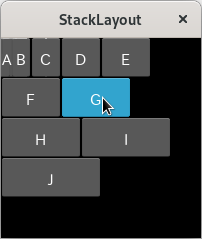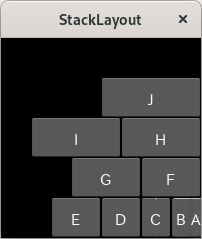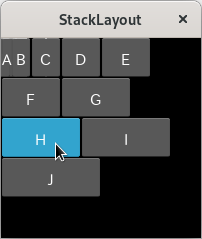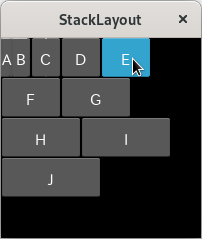Kivy は、NUI (Natural User Interface) を持つモバイルアプリやその他のマルチタッチアプリケーションソフトウェアを開発するためのフリーでオープンソースの Python フレームワークです。MIT ライセンスのもとで配布され、Android, iOS, Linux, macOS そして Windows で動作させることができます。
使ったことのなかった Python の GUI ライブラリ(フレームワーク)、Kivy に興味を持ったので [1]、ひととおりウィジェットのサンプルを作ってみようとしています。サンプルを作っていくにあたって、どんなスタイルでコーディングするか、テンプレートみたいなものを固めていこうとあれこれ試し始めました。
今回はフロートレイアウトのサンプルを紹介します。
Python のコードのみのサンプルと、UI 部分を分離して Kv 言語で記述した同じ動作をするサンプルを併せて紹介しています。
下記の環境で動作確認をしています。

|
Fedora Linux 37 (Server Edition Prerelease) | x86_64 | ||
| python3 | python3.10-3.10.7-1.fc37.x86_64 | |||
| Kivy | 2.1.0 | |||
StackLayout (Python)
StackLayout は、レイアウト内(=親ウィジェットのサイズ)に収まる限り、縦方向または横方向に子ウィジェットを順番に並べて配置します。個々の子ウィジェットのサイズは、均一である必要はありません。
orientation で指定する子ウィジェットの並べ方は、'lr-tb', 'tb-lr', 'rl-tb', 'tb-rl', 'lr-bt', 'bt-lr', 'rl-bt' および 'bt-rl' のいずれかです。t は top、b は bottom、l は left、r は right を表します。
StackLayout (Python + Kv)
指定したファイルを読み込むようにしたかったので、ここでは Builder.load_file() を使って、指定したファイルを読み込むようにしています。
まずは、Kv のベタな記述です。
on_kv_post イベントで(Python 側に)ディスパッチしてループを実行した例です。ループの一行は長いので、可能な個所で改行していますが、インデントを加えられないので却って読みにくいかもしれません。また、ループの内容は Python ですので、わざわざ Kv で記述する必要はないのかもしれません。
参考サイト
- bitWalk's: Kivy をちょろっと使ってみた [2022-07-10]
- Kv language — Kivy 2.1.0 documentation
- Kivy Language — Kivy 2.1.0 documentation
- Widgets — Kivy 2.1.0 documentation
- Stack Layout — Kivy 2.1.0 documentation
にほんブログ村
#オープンソース






0 件のコメント:
コメントを投稿